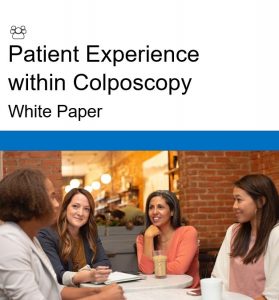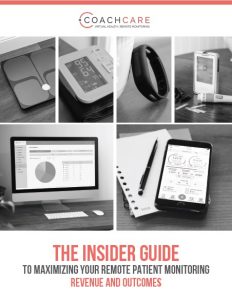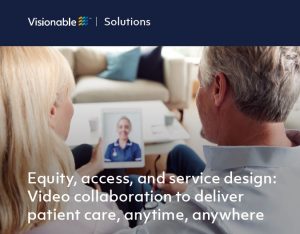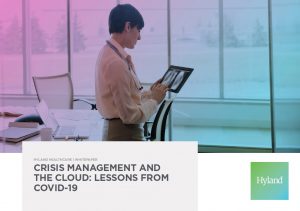Patient Experience within Colposcopy
Publication Overview
Colposcopy helps identify whether cell changes need treatment to stop this happening. If treatment is needed, the patient may be diagnosed and treated during their first visit or be invited to a return appointment for treatment following a biopsy to confirm the disease status.
Along with the natural anxiety caused by a positive (abnormal) screening result, attending colposcopy can be an additional worry for patients and result in high levels of anxiety before and during colposcopy which can have adverse effects including pain and discomfort during the procedure and high rate of women not returning for follow-up examination.
This white paper looks at the experience of patients undergoing a colposcopy examination with the ZedScan electrical impedance spectroscopy diagnostic device used as an adjunct, to assess if its use had a positive impact on patient experience and anxiety levels.
Download this white paper for free>>
Paper written by Zilico
The Insider Guide to Maximizing your Remote Patient Monitoring Revenue and Outcomes
Publication Overview
Remote Patient Monitoring (RPM) is revolutionizing the way in which modern healthcare is provided. With demand on health systems soaring there is a need to manage patients and provide services in new ways that help reduce costs and improve outcomes, across all aspects of the care continuum.
This White Paper, from leading RPM provider CoachCare, is your INSIDER GUIDE TO MAXIMIZING YOUR REMOTE PATIENT MONITORING REVENUE AND OUTCOMES…
Download this white paper for free>>
Paper written by Coachcare
Positioning Paper: Visionable
Publication Overview
Video conferencing in healthcare has become more prevalent than ever in 2020. But for Visionable this is just the beginning of what video-based collaboration can achieve.
The NHS technology partner is helping to deliver equitable access to services for patients. It is helping health and care organisations to redesign services, pathways, and workflow. It is connecting healthcare professionals and bringing them to the patient. It is supporting entirely new ways of delivering, coordinating and structuring multi-disciplinary teams. It is bringing together crucial patient information and imaging to support virtual consultations and meetings. It is helping the NHS meet sustainability ambitions, whilst saving substantial amounts of time. And it is doing all this in close partnership with health and care services and the people who rely on its technology – professionals and patients.
Read this positioning paper from Visionable here >>
Paper written by Visionable
Flying Blind or Taking Control – Opportunities and Requirements for Personal Sensors that Measure Our Health
Publication Overview
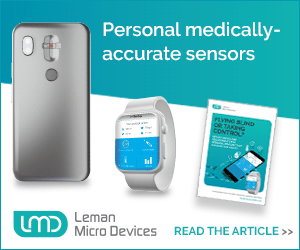 The first generation of sensors were aimed at tracking fitness, making simple measurements of inputs (what have I done?) such as how many steps have I taken today rather than outputs (how is my health?). The second generation picked off easier health-related targets like pulse rate (heart rate) but have struggled to find a use for the results.
The first generation of sensors were aimed at tracking fitness, making simple measurements of inputs (what have I done?) such as how many steps have I taken today rather than outputs (how is my health?). The second generation picked off easier health-related targets like pulse rate (heart rate) but have struggled to find a use for the results.
The third generation is emerging, measuring what we really need to know: the Vital Signs, as used by doctors everywhere. These are not toys, they are regulated medical devices: accurate credible and safe.
This White Paper examines such devices using LMD’s V-Sensor as a model…
Download this white paper for free>>
Paper written by Leman Micro Devices
Crisis Management and the Cloud: Lessons from COVID-19
Publication Overview
The COVID-19 pandemic has changed the course of healthcare delivery for the foreseeable future. It has asked hospital systems to make both patient care and staffing decisions in the blink of an eye — and implement the technology to quickly support those decisions.
In this whitepaper, learn how moving to, or enhancing, the cloud will help your organisation act on game-changing decisions faster and with the support to do it right.
Download this white paper for free>>
Paper written by Hyland Healthcare
Beyond The Clinic: From Telemedicine to Remote Treatment
Publication Overview
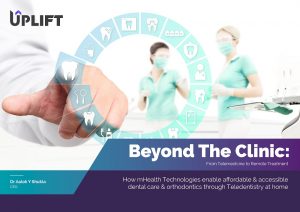 Every week 7500 UK citizens visit their GP instead of dentist. Less than 50% of adults visit a dentist regularly and 30% of children have not seen a dentist in 2 years. Dental disease and its complications impose significant financial burdens to the individual and society globally.
Every week 7500 UK citizens visit their GP instead of dentist. Less than 50% of adults visit a dentist regularly and 30% of children have not seen a dentist in 2 years. Dental disease and its complications impose significant financial burdens to the individual and society globally.
In this whitepaper a new mHealth model for Dentistry is shown in a scalable and digital method using teledentistry, which can serve as a model for the digitisation of other primary care specialities.
Download this white paper for free>>
White paper written by Dr Aalok Y Shukla, Uplift
What is the Internet of Medical Things?
Publication Overview
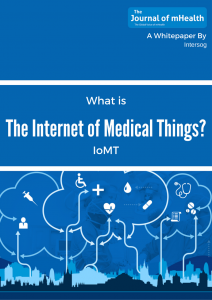 The Internet of Medical Things (IoMT) is set to change the way that the medical industry delivers healthcare. As with the other disruptive changes that have come from the IoT and other digital revolutions, there will be challenges that face the IoMT.
The Internet of Medical Things (IoMT) is set to change the way that the medical industry delivers healthcare. As with the other disruptive changes that have come from the IoT and other digital revolutions, there will be challenges that face the IoMT.
This whitepaper discusses the protocols platforms and equipment that are driving the Internet of Medical Things, including:
-
Key Challenges of the IoMT Implementation
-
How to Foster Adoption of the IoMT
-
IoMT Connected Tech And Smart Gadgets
-
Technologies Behind the IoMT
Download this white paper for free>>
White paper developed by Intersog and The Journal of mHealth
Exposing Benefits and Barriers: mHealth Use in Managing Hemophilia
Publication Overview
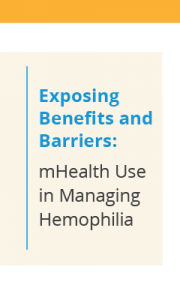 Hemophilia is a genetic bleeding disorder caused by a deficiency or absence of a clotting factor protein. Treatment for hemophilia is often through an infusion of the missing clotting protein (factor). Considerable clinical evidence has shown prophylaxis treatment (replacement of clotting factor) prevents bleeding from an early age, allowing those living with hemophilia to lead a fuller life with minimal restrictions. Yet, despite medical recommendations, many patients do not consistently remain adherent to their prophylactic schedule.
Hemophilia is a genetic bleeding disorder caused by a deficiency or absence of a clotting factor protein. Treatment for hemophilia is often through an infusion of the missing clotting protein (factor). Considerable clinical evidence has shown prophylaxis treatment (replacement of clotting factor) prevents bleeding from an early age, allowing those living with hemophilia to lead a fuller life with minimal restrictions. Yet, despite medical recommendations, many patients do not consistently remain adherent to their prophylactic schedule.
The advent of mobile health apps provides a new alternative to managing bleeding disorders. Individuals can set reminders and track their treatment, record information related to bleeds, generate logs, access additional resources, and even locate a hemophilia treatment center (HTC), while traveling, all from the palm of their hand. Despite the potential benefits mHealth offers, many people have not embraced this new technology.
BioMatrix, the parent company for a family of industry-leading specialty pharmacies, conducted a study investigating the use of hemophilia mobile apps. The purpose of the study was to provide insight into the current use of hemophilia mHealth, to increase awareness of potential benefits, and to provide recommendations to increase usage with the goal of improving health outcomes for people living with bleeding disorders.
A cross-sectional survey was conducted with severe hemophilia patients. This was followed by a systematic evaluation of current hemophilia mobile apps within focus group meetings. Results of the study are published in this white paper, Exposing Benefits and Barriers: mHealth Use in Managing Hemophilia (November 2017).
Download this white paper for free>>
Written by Diane Horbacz, MEd, BioMatrix
Telephone-based Speech Analytics in Healthcare Barriers
Publication Overview
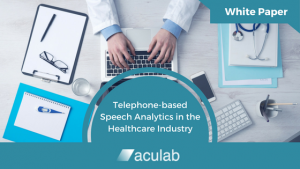 In this practical publication, leading communications provider, Aculab, outlines how healthcare providers can utilise a telephone-based voice and speech analysis system as a cost-effective means of contributing to the management of certain disorders and diseases.
In this practical publication, leading communications provider, Aculab, outlines how healthcare providers can utilise a telephone-based voice and speech analysis system as a cost-effective means of contributing to the management of certain disorders and diseases.
Speaking is something that most of us tend to take for granted. Unfortunately, there are those for whom it becomes a problem. And as clinicians and speech therapists will tell you, such problems can strike at any moment in a person’s life. Speech can be adversely affected by many diseases and disorders. Conditions such as apraxia and dysarthria can result from a variety of causes, including: stroke, brain injury or progressive illnesses.
Speech dysfunction is evaluated by medical professionals such as specialist clinicians and therapists, and currently, this process of screening and monitoring patients usually requires face-to-face meetings. For some health authorities, budget permitting, it can also involve a certain amount of technology, much of which is dated. Regular meetings between patient and clinician are needed in order to monitor a patient’s vocal health and the progress of any treatment, which is undoubtedly costly to both parties and offers a significant incentive for innovation.
In this white paper, telecoms innovator, Aculab, outlines opportunities to use technology to enable clinicians to offer an alternative, outpatient service that can be accurate, efficient and cost-effective – without compromising ongoing treatment or diagnosis.

